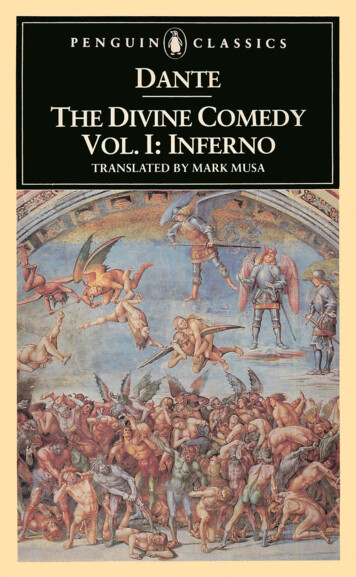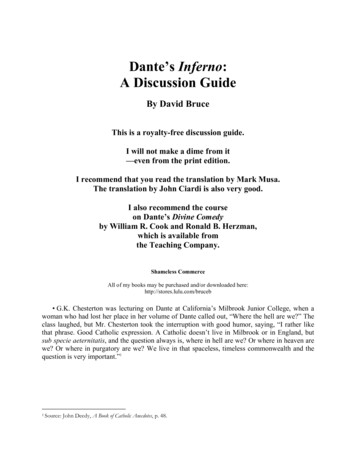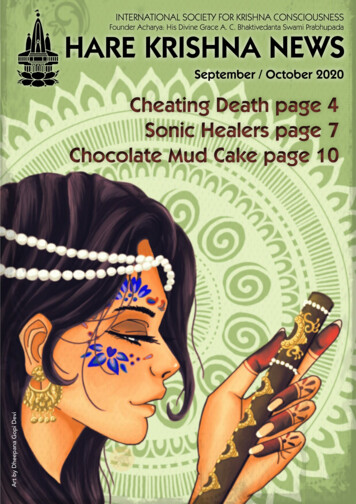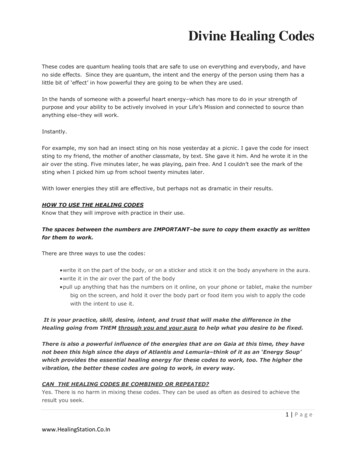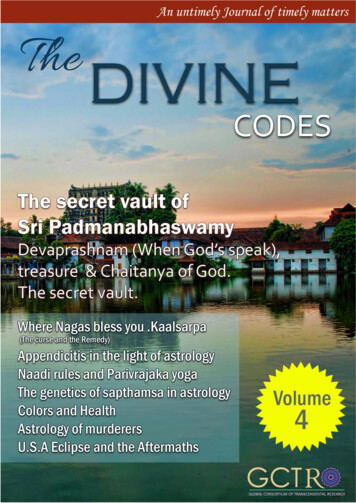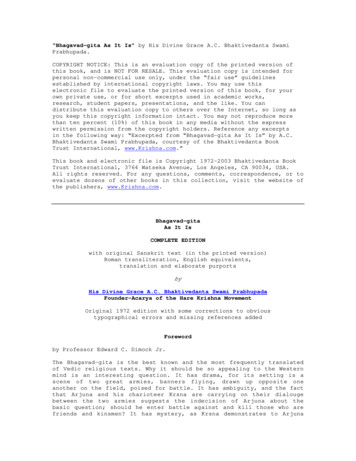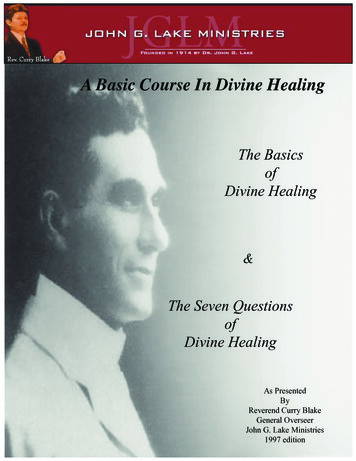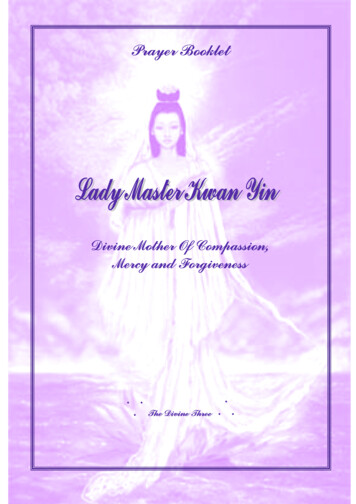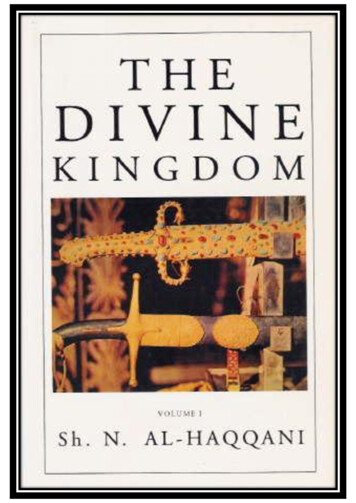
Transcription
Dante’sDIVINE COMEDYThe InfernoPu r g a t o r i oPa r a d i s oTranslated by ROBERT and JEAN HOLLANDERIllustrated by GUSTAVE DORÉ and SANDOW BIRK“Follow You Down” by MARK M C ADAM
CONTENTSDante & Virgil: A Match Made in HellWho was Beatrice Portinari?The Divine Comedy as an AllegoryCantos I and II Video ClipWhat is a Classic?Cantos III and IV Video ClipCanto V Video ClipCantos VI and VII Video ClipCantos VIII and IX Video ClipCanto XI Video ClipPictures Worth a Thousand WordsCircle VIII Video ClipWorks Cited
CONTENTSDante & Virgil: A Match Made in HellWho was Beatrice Portinari?The Divine Comedy as an AllegoryCantos I and II Video ClipWhat is a Classic?Cantos III and IV Video ClipCanto V Video ClipCantos VI and VII Video ClipCantos VIII and IX Video ClipCanto XI Video ClipPictures Worth a Thousand WordsCircle VIII Video ClipWorks Cited
DANTE and VIRGILBy the time Dante Alighieri (1265-1321) had finished the fourth canto of TheInferno and set his name down alongside six of the all-time great writers, he hadalready decided he was writing a classic—a work that would be loved, over time,by millions of more-or-less ordinary readers and by thousands of scholars.Exiled from Florence in 1302 for his political affiliations and estranged fromhis wife, Dante began work on his Divine Comedy. The poem absorbed almost allof his time and energy. Its motivating idea is a simple one, outrageously so. Inthe Easter period of 1300 a thirty-five-year-old Florentine, struggling withfailure and apparently spiritual death, is rescued by the shade of the Roman poetVirgil. Exactly when he began seriously writing the grand three-part poem hasalways been difficult to determine (the year 1306 is a frequently suggestedpossibility), but he seems to have finished The Inferno by 1314, and Paradisoshortly before he died in 1321. It is perhaps difficult to imagine how even a Dante could have managed to buildso magnificent an edifice out of so improbable a literary idea. The result was a book that began to be talkedabout, known from parts that seem to have circulated before the whole, even before it was finished (the firstcitations begin to be noted around 1315). Within months of his death commentaries upon it began to beproduced. It was, in short, an instant classic, the first of its kind since Virgil’s Aeneid. Today, his Divine Comedy iswidely considered the most important poem of the Middle Ages and the greatest work in the Italian language.
A MATCH MADE in HELLThere are few surprises awaiting the reader of the Comedy asunsettling as to find a pagan poet serving as a guide in aChristian poem. Virgil (ca. 70-19 BC) is traditionallyranked as one of Rome’s greatest poets, and his Aeneid hasbeen considered the national epic of ancient Rome since the timeof its composition. We have perhaps gotten so used to the ideaof Dante’s Virgil that we forget to be surprised by it. Lesserminds would have made a less provocative choice. For reasonsdifficult to fathom, Dante needed Virgil in order to make thispoem; and he wanted him to serve as a central character in it.
STAR-CROSSED LOVERSWho was Beatrice? As with much of the scholarship and criticismsurrounding the Divine Comedy, there is considerable debateabout this character. Robert Hollander writes, “We know absolutelynothing certain about her, whether she was an actual woman orwhether she is a fictitious lady of the sort that love-poets invented inorder to have a subject to write about” (xxiv). Dante claims tohave met a “Beatrice” only twice, on occasions separated by nineyears, but was so affected by the meetings that he carried his love forher throughout his life. This is believed to be Beatrice Portinari,who ultimately married someone else and who died at the age of 24.
ALLEGORYAn allegory is a narrative,whether in prose or verse, in whichthe agents and actions, andsometimes the setting as well, arecontrived by the author to makecoherent sense on the “literal,” orprimary, level of signification, andat the same time to signify asecond, correlated order ofsignification. There are two maintypes: historical and politicalallegory, in which the charactersand actions that are signifiedliterally in their turn represent, or“allegorize,” historical personagesand events, and the allegory ofideas, in which the literalcharacters represent concepts andthe plot allegorizes an abstractidea (Abrams and Harpham 8).
“The allegory of the Comedy is notallegory as the commentators urge me toapply it. I may read this poem as history,and understand it better.”– Robert Hollander
CANTO ICANTO IIWhat is the significance of theseason and time of day whenDante sets out on his journey?Why does Dante stop trying toleave the dark wood, ultimatelyfalling deeper into despair?When Virgil arrives, he tellsDante that he can be his guidethrough Hell and Purgatory butnot Heaven. Why can’t Virgilshow Dante Heaven?Who sends Virgil from the netherregions to find Dante? Why doeshe or she ask Virgil to do this?Give two examples from anywherein Cantos I or II of Dante’srecurrent use of the number three.What is the significance of theseason and time of day whenDante sets out on his journey?Why does Dante stop trying toleave the dark wood, ultimatelyfalling deeper into despair?When Virgil arrives, he tellsDante that he can be his guidethrough Hell and Purgatory butnot Heaven. Why can’t Virgilshow Dante Heaven?Who sends Virgil from the netherregions to find Dante? Why doeshe or she ask Virgil to do this?Give two examples from anywherein Cantos I or II of Dante’srecurrent use of the number three.
Cantos I & II
WHAT IS A CLASSIC?A classic is a text that has a permanent significance, or carries a permanentmessage, for all generations; its words remain always the same, but theirmeanings slowly change by adapting themselves to the needs and aspirations of thevarious ages, as we ride on the rhythm of time. In other words, a classic is a textthat never belongs to the past but always to the present, and that is, therefore,always contemporary, a text in which human beings, precisely because they arehuman beings, keep rediscovering themselves.
Cantos III & IV
Canto V
Cantos VI & VII
Cantos VIII & IX
Canto XI
DRAWING DANTEWhat does it mean for Sandow Birk to beremapping his droll and detailedcontemporary social observations ontoGustave Doré’s classic prints? Turn to page16 of your packet to answer this question.
Circle 8:THE TEN MALEBOLGE
Reading ComprehensionCIRCLE IXWhich character, or characters, guard the ninth Circle ofHell? How does the guard try to deter intruders?While walking across Cocytus, Dante is alarmed by anuncanny breeze, asking Virgil, “‘Are not all winds banishedhere below?’” (XXXIII.105). How does Virgil respond toDante’s question, and what causes the wind to blow?One of the motifs Dante uses throughout the DivineComedy is the use of the number three. Give two examplesfrom anywhere in Cantos XXXI-XXXIV of this recurrentthematic element.Who “bears the greatest pain” in all of Hell? What did thischaracter do that Dante finds so repulsive?How are Virgil and Dante able to escape from Hell? Describethe sequence of events which lead to them being able to set footon earth’s surface again and gaze at the heavenly stars.
Make a slide for the 9 circles Poster assignment!
What emerges from an archetypal approach to Dante’s Inferno is instructive because it clearlydemonstrates that Dante was writing on a symbolic level of a universal condition that is outside oftime and therefore applicable to all human beings. Juxtaposing a scene from the conclusion of StarWars: The Force Awakens (2015) with the introduction the Divine Comedy (1321) will hopefullyillustrate this concept. The awakening in the dark wood can be considered the typical starting point ofthe journey to the center of the self, which is what the Divine Comedy represents. The forest atnighttime is the first manifestation of what psychologist Carl Jung called the Shadow—the part of theunconscious that holds the unknown or little-known attributes and qualities of the ego—andcorresponds to the first stage in the process of individuation, that is, becoming aware of one’sunconscious and confronting fears and repressed emotions. The Shadow, the dark and dangerousaspect of the unconscious, must be confronted directly if the process of individuation is to continue.This explains why Dante cannot ascend to the mountain of purgatory directly from the dark wood.The evil within him must be faced, recognized, assimilated, and transformed: in the language ofmythology, the dragon must be slain. Dante must come to terms with those energies that lurk in thedark wood in an undifferentiated form. How does this theory align with Rey’s encounter with KyloRen?
And yet, in legends such as Robin Hood, or the great Hindu love story of Rama and Sita,forest becomes a hiding place, a sanctuary. The forest provides refuge for great heroes whoafter a period of exile re-emerge into the world to fight for vengeance and justice. Their timein the forest (a full fourteen years in the case of Rama) could perhaps be interpreted as aperiod of personal development. A rite of passage perhaps?In his book The Uses of Enchantment: The Meaning And Importance of Fairy Tales, BrunoBettelheim explores the significance of the forest in fairy tales. He writes:‘Since ancient times the near impenetrable forest in which we get lost has symbolized thedark, hidden, near-impenetrable world of our unconsious. If we have lost the frameworkwhich gave structure to our past life and must now find our way to become ourselves, andhave entered this wilderness with an as yet undeveloped personality, when we succeed infinding our way out we shall emerge with a much more highly developed humanity.’The forest offers an antithesis to the town. In ancient times when Europe was greatlycovered by woodland, the forest represented the boundary of civilisation. The forest wasliterally a wild place, the village or town merely a place where man had cleared a settlement.There were many who found refuge in the forest, not just criminals, and those in exile, butshamans, holy men and women, poets, freethinkers and of course trolls, elves and fairies.Even in contemporary fairytales such as Nausicaa, Hirao Miyazaki’s film about a young girl’sfight to save a post-apocalyptic world, the forest is a healing place, where trees filter the
THE DIVINE COMEDYARTWORK BYGERALD SCARFEBy Dante Alighieri
STAR-CROSSED LOVERSWho was Beatrice? As with all of the literary criticism surrounding the DivineComedy, there is considerable debate about this character. Robert Hollander writes,“We know absolutely nothing certain about her, whether she was an actual womanor whether she is a fictitious lady of the sort that love-poets invented in order to havea subject to write about” (xxiv). Dante claims to have met a “Beatrice” onlytwice, on occasions separated by nine years, but was so affected by the meetings thathe carried his love for her throughout his life. This is believed to be BeatricePortinari, who ultimately married someone else and who died at the age of 24.
Dante’sDIVINE COMEDYTr a n s l a t e d b y R O B E RT A N D J E A N H O L L A N D E RIllustrated by SANDOW BIRK
Pre s e n t a t i o n b y M AT T H E W Q U E R I N O
Open Response? Passage from Grendel.“Theories. They’d map out roads through Hell with their crackpottheories, their here-to-the-moon-and-back lists of paltry facts.Insanity—the simplest insanity ever devised! Simple facts inisolation, and facts to connect them—ands and buts—are the sinequa non of all their glorious achievement. But there are no suchfacts. Connectedness is the essence of everything. It doesn’t stopthem, of course. They build the whole world out of teeth deprivedof bodies to chew or be chewed on” (64).
and cultural practice as well. In this context, Birk maintains a solid link with Dante’s imaginationand brings it forward to our own time in a very contemporary—and disturbing—fashion.This particular collection of illustrations is the living witness of an artist who has the ability tosee beyond the story he illustrates. The story is about Hell—the eternal absence of God—andabout the deliberate choice of evil over good. In every case, the punishment fits the sin. But lookbeyond Dante and Virgil and the sinners they encounter. The background, the very context, isour world. This is deeply disturbing, but it is not beyond our recognition. Strewn with thedetritus of the crumbling megalopolis, Birk’s illustrations portray the City of Dis inhabited notonly by Dante’s sinners; he has taken to heart Dante’s own torment and struggle, woven tightlyinto the “visual” background of the poem.Strangely enough, but fittingly, the Inferno is a feast for the senses—especially the eyes. Birk’sillustrations astonishingly juxtapose the horror of Dante’s vision with the modern cityscape. Thenight sky is not filled with stars, but the cold blue search-lights of police helicopters, devil-like,chasing modern-day sinners. Dark alleys, ugly streets, freeway overpasses, traffic signs,commercial logos—even the city’s new cathedral—all crowd upon us to provide a backdrop forthe drama of Dante’s journey with Virgil through a city ordered by chaos.Birk’s images reimagine and update Dante’s Divine Comedy for postmodern readers, making thismonumental text more accessible. We find ourselves standing alongside Dante and Virgillooking—sometimes with curiosity, other times with horror—upon the eternal consequences offree human choice. Herein Birk captures in his illustrations the visual muscle of Dante’s text—and his genius.
We live in a very different world from Dante’s. On every level, the collectiveprogress of human achievement through the Renaissance; theEnlightenment; and the industrial, scientific, and technological revolutions;has given us the potential to use what we have achieved for great good.And so we strive. But we also live in a world very much like Dante’s. Politicalintrigue and betrayal among statesmen; war, violence, and destruction;dishonest business practices at the highest levels; loss of faith in timehonored institutions—these and other social ills make the darkness ofDante’s Inferno visible and render us vulnerable to forces of evil, not alwaysvisible on apocalyptic levels, but felt in the despair and hopelessness thatbecome the unwanted homeless who populate the streets of our hearts.
InfernoDante’s DIVINE COMEDY
Inferno and set his name down alongside six of the all-time great writers, he had already decided he was writing a classic—a work that would be loved, over time, by millions of more-or-less ordinary readers and by thousands of scholars. Exiled from Florence
